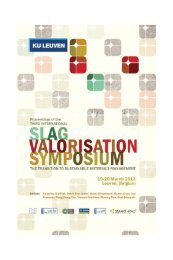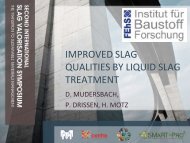International Slag Valorisation SymposiumLeuven6-7/4/2009 - Third ...
International Slag Valorisation SymposiumLeuven6-7/4/2009 - Third ...
International Slag Valorisation SymposiumLeuven6-7/4/2009 - Third ...
You also want an ePaper? Increase the reach of your titles
YUMPU automatically turns print PDFs into web optimized ePapers that Google loves.
further, by treating the other stacks of the steel mill: the cost of abatement would of<br />
course be higher. With this rationale, though, zero emissions could be achieved.<br />
Figure 6: Schematics of the ULCORED process<br />
In parallel to ULCOS, other programs have been launched under the umbrella of the<br />
worldsteel CO2 Breakthrough Program. 6) Their rationale is similar to the one of<br />
ULCOS. They are less advanced in terms of making Breakthrough Technologies<br />
available. This long development on Breakthrough Technologies shows that there is no<br />
simple recipe for cutting the present CO2 emissions of the Steel Industry by 50% or<br />
more (the objective of the ULCOS program): new technologies have to be developed,<br />
which means a high level of risk, incompressible development time, large budgets for<br />
R&D and then large capital expenditures to convert steel mills to the Breakthrough<br />
processes. Moreover, the economic viability of these solutions, which definitely are not<br />
no-regret, will depend on the price of CO2 and on the implementation of a level playing<br />
field for climate policies all around the world that avoid “carbon-havens” and therefore<br />
carbon leakage, especially out of Europe. With all these caveats, the Steel Industry can<br />
cut its emissions significantly and continue to provide a material that the world needs to<br />
ensure a good life to its citizens and cut CO2 emissions in other sectors.<br />
CCS for the Steel Sector<br />
This section will refocus on CCS for the Steel sector, because implementing CCS seems<br />
to be the quickest way – in the 2020s – to delivering significant cuts in the CO2<br />
emissions of the sector. The first point is that CCS will be implemented in the Steel<br />
Industry without matching any of the existing CCS categories, which have been defined<br />
with the context of energy generation in mind. Indeed, in the Steel sector, the major part<br />
of the generation of CO 2 is related to the reduction of the iron oxides that constitute iron<br />
ore. Oxyfuel combustion, pre- or post-combustion capture chemical looping do not<br />
1 st <strong>International</strong> <strong>Slag</strong> <strong>Valorisation</strong> Symposium│Leuven│6-7/4/<strong>2009</strong><br />
22







